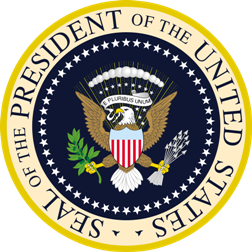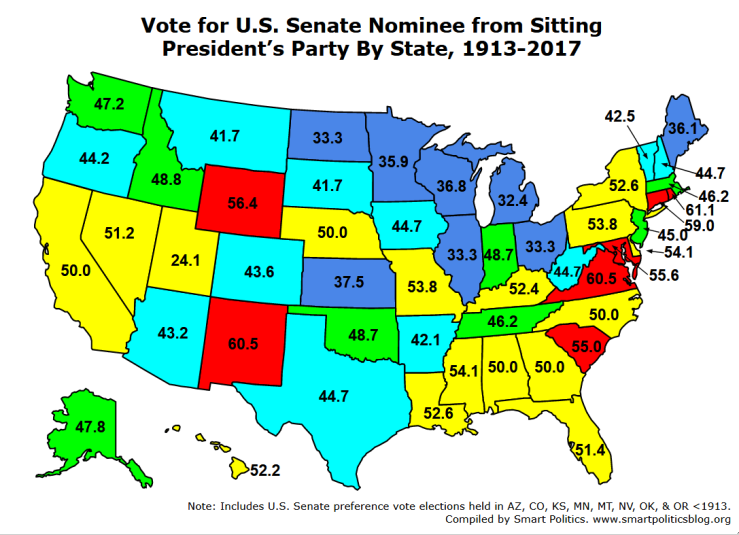Midwestern Naysayers: Which States Are Least Likely to Elect US Senators from the President’s Party?
Each of the Top 5 and eight of the Top 10 states which have most frequently elected U.S. Senators from a party other than the sitting president are located in the Midwest; five host contests in 2018

Overall, the president’s party has won 47.4 percent of U.S. Senate elections, but there has been a fair bit of variation across the 50 states.
And the region that has most commonly thumbed its nose and voted for a check on the president when voting in U.S. Senate races has been the Midwest.
Smart Politics reviewed nearly 1,900 U.S. Senate elections since 1913 and found that each of the Top Five and eight of the Top 10 states with the highest rate of voting for a party other than that of the sitting president in U.S. Senate elections are located in the Midwest – Michigan, Illinois, North Dakota, Ohio, Minnesota, Wisconsin, Kansas, and South Dakota.
Five of these Midwestern states hold elections in 2018 – Michigan, Minnesota (both seats), North Dakota, Ohio, and Wisconsin.
Overall, Michigan has been the nation’s biggest naysayer – voting for a nominee opposing the president’s party more than two-thirds of the time.
Since its first direct election for the office in 1916, Michigan has elected a nominee from the president’s party in just 12 of 37 elections, or 32.4 percent.
That number is expected to drop this November with three-term Democrat Debbie Stabenow heavily favored in her reelection bid. Prior to wins by Stabenow (2012) and Gary Peters (2014) when Barack Obama was in office, Wolverine State voters only backed candidates from the president’s party in two of 10 contests from 1982 through 2008.
Illinois, North Dakota, and Ohio have elected nominees from the president’s party just 33.3 percent of the time over the last century (13 of 39 elections for each), followed by Minnesota at 35.9 percent (14 of 39).
Wisconsin (36.8 percent), Kansas (37.5 percent), and South Dakota (41.7 percent) also round out the Top 10 naysayers along with two non-Midwestern states: Maine (36.1 percent) and Montana (41.7 percent).
Seven of these 10 states host a total of eight U.S. Senate elections this cycle – and Republicans are not currently favored to win any of them.
In addition to Stabenow in Michigan, Democrats are expected to win in Ohio (Sherrod Brown), Minnesota (Amy Klobuchar, Tina Smith), and Wisconsin (Tammy Baldwin), are slightly favored in Montana (Jon Tester), and face a toss-up race in North Dakota (Heidi Heitkamp). Independent Angus King is also strongly favored to win a second term in Maine.
Overall, the Midwest region has been the least likely to elect U.S. Senate nominees from the president’s party over the last 100+ years, doing so in 185 of 461 races (40.1 percent).
The South (50.2 percent), Northeast (50.0 percent), and West (48.6 percent) regions have backed nominees from the party of the president approximately half of the time.
But the past is not always prologue, and many states which have tended to vote more frequently with the president’s party will almost assuredly not be doing so in November.
Rhode Island has been the most reliable state to elect nominees from the party of the president in U.S. history (61.1 percent), but Democratic incumbent Sheldon Whitehouse is clearly in no danger of being ousted this autumn. From 1924 through 1952, the winners of 12 consecutive Rhode Island U.S. Senate elections were from the same party as the sitting president.
Nor are Democrats Tim Kaine of Virginia (60.5 percent), Martin Heinrich of New Mexico (60.5 percent), Chris Murphy of Connecticut (59.0 percent), Ben Cardin of Maryland (55.6 percent), Tom Carper of Delaware (54.1 percent), and Bob Casey of Pennsylvania (53.8 percent) in much danger of losing to a GOPer in two months.
The longest current streak in the country for voting against the president’s party in U.S. Senate races is only four, held by seven states: Alabama, Alaska, Iowa, Louisiana, North Carolina, South Carolina, and South Dakota.
Likewise, the longest streak voting with the president’s party is also four (Hawaii).
Follow Smart Politics on Twitter.


2019-2020: a) The aforementioned pattern suggests that the R nominee in ME (presumably four-term incumbent Collins) is in much danger of being ousted from her seat – and this is in addition to the “ranked choice voting” wild card and the (expected) negative presidential coattail statewide. b) While it seems highly unlikely that the party nominees in IA, KS, NE, SD, and MT will all lose, the group as a whole perhaps ought to be at least somewhat concerned, particularly should the economic conditions in this broad swath worsen as a result of trade wars arguably initiated by the ‘Dear Leader’ of their party.